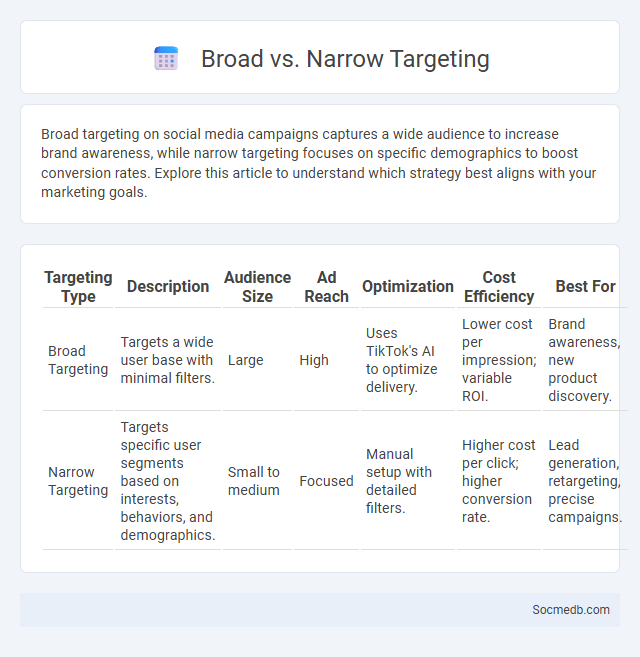
Photo illustration: Broad vs Narrow targeting
Broad targeting on social media campaigns captures a wide audience to increase brand awareness, while narrow targeting focuses on specific demographics to boost conversion rates. Explore this article to understand which strategy best aligns with your marketing goals.
Table of Comparison
| Targeting Type | Description | Audience Size | Ad Reach | Optimization | Cost Efficiency | Best For |
|---|---|---|---|---|---|---|
| Broad Targeting | Targets a wide user base with minimal filters. | Large | High | Uses TikTok's AI to optimize delivery. | Lower cost per impression; variable ROI. | Brand awareness, new product discovery. |
| Narrow Targeting | Targets specific user segments based on interests, behaviors, and demographics. | Small to medium | Focused | Manual setup with detailed filters. | Higher cost per click; higher conversion rate. | Lead generation, retargeting, precise campaigns. |
Introduction to Targeting Strategies
Targeting strategies on social media allow you to reach specific audiences based on demographics, interests, behaviors, and location. By leveraging data analytics and platform tools, your campaigns become more efficient and personalized. Effective targeting increases engagement rates and maximizes the return on your advertising investment.
What is Broad Targeting?
Broad targeting in social media advertising refers to a strategy where marketers aim their ads at a wide and diverse audience without extensive demographic or interest-based restrictions. This approach leverages the platform's algorithms to identify and reach potential customers who may not fall into narrowly defined segments but show behaviors or signals indicating interest. Broad targeting can increase reach and help discover new audience segments, driving brand awareness and potential conversions through algorithmic optimization.
Advantages of Broad Targeting
Broad targeting on social media allows advertisers to reach a vast and diverse audience, increasing brand visibility and potential customer acquisition. This approach leverages platform algorithms to optimize ad delivery, ensuring your message reaches users most likely to engage without restricting demographic criteria. You benefit from enhanced campaign scalability and cost-efficiency by tapping into wider market segments and uncovering unexpected customer bases.
What is Narrow Targeting?
Narrow targeting in social media refers to the precise selection of audience segments based on specific demographics, interests, behaviors, or location to maximize campaign effectiveness. It allows advertisers to concentrate their messaging on users who are most likely to engage or convert, reducing wasted ad spend and increasing return on investment. By leveraging narrow targeting, You can tailor your content to resonate deeply with your ideal customer profile, enhancing engagement and driving better results.
Benefits and Drawbacks of Narrow Targeting
Narrow targeting on social media allows you to reach a highly specific audience, increasing the relevance of your ads and improving conversion rates. This precise approach minimizes ad spend waste by focusing only on users most likely to engage with your content. However, overly narrow targeting can limit your campaign's reach, potentially reducing overall brand awareness and missing out on new customer segments.
Understanding Audience Targeting
Understanding audience targeting on social media involves analyzing demographics, interests, and online behaviors to deliver personalized content that resonates with Your specific followers. Platforms like Facebook, Instagram, and LinkedIn offer advanced tools to segment audiences based on age, location, and engagement patterns, enhancing campaign effectiveness. Tailoring messages to targeted groups increases relevance, boosts engagement rates, and maximizes return on ad spend.
Key Differences: Broad vs Narrow vs Audience Targeting
Broad targeting on social media casts a wide net to reach a large, diverse group, maximizing brand visibility but often resulting in lower conversion rates. Narrow targeting focuses on specific demographics or interests to increase engagement and relevance, improving your campaign's efficiency by attracting highly interested users. Audience targeting leverages data from previous interactions or behaviors, allowing you to personalize ads and optimize ROI by reaching users most likely to convert based on their past actions.
When to Use Each Targeting Approach
Selecting the right social media targeting approach depends on your campaign goals and audience insights. Use demographic targeting to reach users based on age, gender, and location, ensuring your content aligns with their profiles. Behavioral and interest-based targeting optimize engagement by connecting Your brand with users whose online activities and preferences match your offerings.
Measuring Success: Targeting KPIs
Measuring success on social media requires targeting key performance indicators (KPIs) such as engagement rate, reach, and conversion rate. Monitoring metrics like click-through rates, follower growth, and sentiment analysis provides insights into audience behavior and campaign effectiveness. Optimizing these KPIs enables brands to refine strategies, enhance content relevance, and maximize return on investment (ROI).
Choosing the Right Targeting for Your Campaign
Selecting the right targeting for your social media campaign ensures that your content reaches the most relevant audience, maximizing engagement and conversion rates. Detailed options such as demographic filters, interest categories, and behavioral data enable precision targeting tailored to your campaign goals. By understanding and leveraging these targeting parameters, you optimize your ad spend and increase the overall effectiveness of your social media marketing strategy.
 socmedb.com
socmedb.com